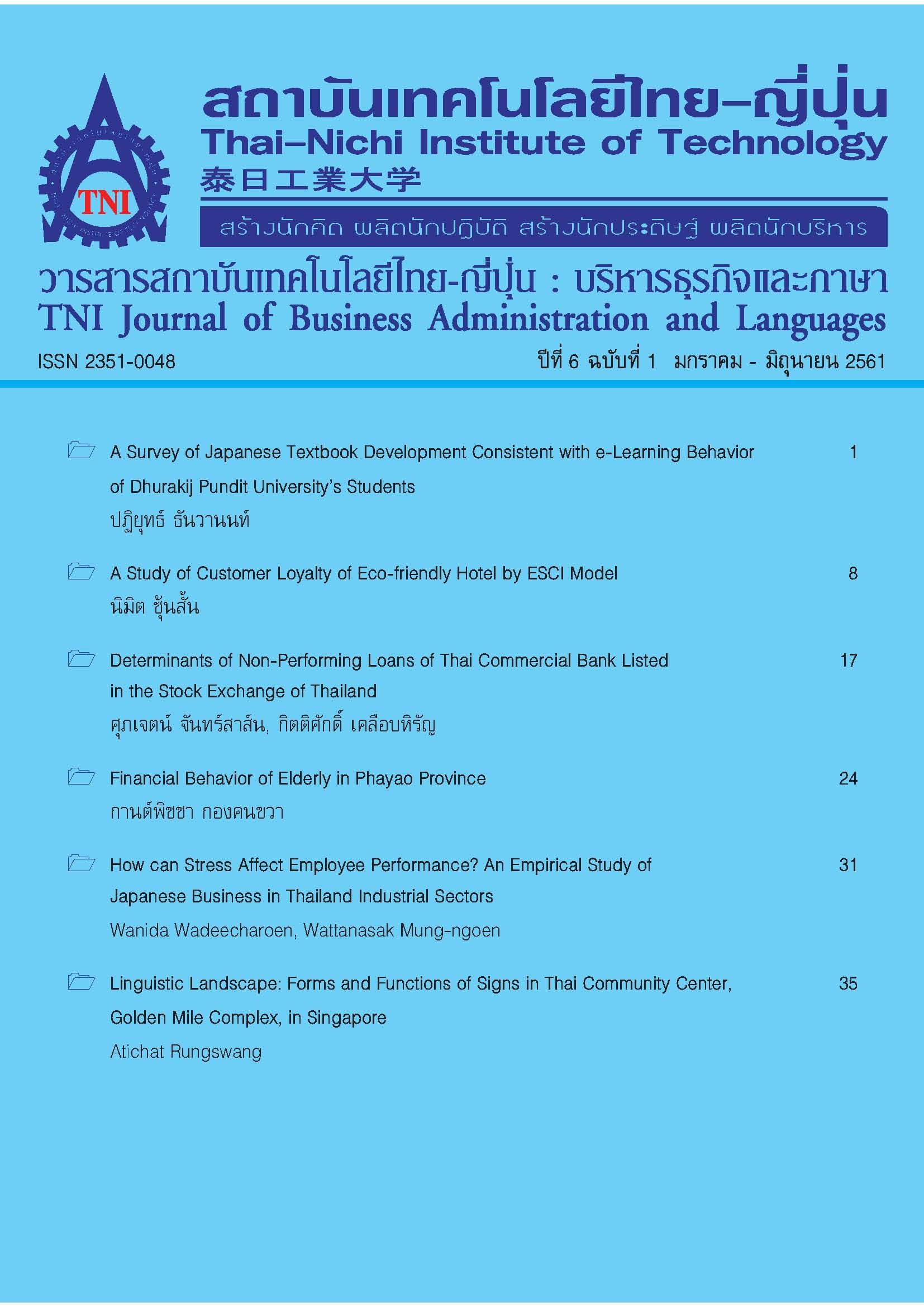Linguistic Landscape: Forms and Functions of Signs in Thai Community Center, Golden Mile Complex, in Singapore
Main Article Content
บทคัดย่อ
Research into linguistic landscape (LL) has recently received attentions from academics in social science fields such as applied linguistics or media studies, since there has been linguistic diversity existing in many countries. Aiming to extend this line of research, this study explored the linguistic landscape by investigating forms and functions of signs in Thai community center in Singapore. The data were 97 shop signs, and the analytical methods was LL methodology. They were analyzed into two main parts; language use and language function. The findings reveal that English is the dominant language in this area. Bilingual sign is the type of sign which is used the most. For the language function, “shop name” is used more than “shop detail”. English used in most of shop-name signs has a function as transcription of Thai language.
Article Details
นโยบายการรับบทความ
กองบรรณาธิการวารสารสถาบันเทคโนโลยีไทย-ญี่ปุ่น มีความยินดีรับบทความจากอาจารย์ นักศึกษา และผู้ทรงคุณวุฒิในสาขาบริหารธุรกิจและภาษา ที่เขียนเป็นภาษาไทยหรือภาษาอังกฤษ ซึ่งผลงานวิชาการที่ส่งมาขอตีพิมพ์ต้องไม่เคยเผยแพร่ในสิ่งพิมพ์อื่นใดมาก่อน และต้องไม่อยู่ในระหว่างการพิจารณาของวารสารอื่นที่นำส่ง ดังนั้นผู้สนใจที่จะร่วมเผยแพร่ผลงานและความรู้ที่ศึกษามาสามารถนำส่งบทความได้ที่กองบรรณาธิการเพื่อเสนอต่อคณะกรรมการกลั่นกรองบทความพิจารณาจัดพิมพ์ในวารสารต่อไป ทั้งนี้บทความที่สามารถเผยแพร่ได้ประกอบด้วยบทความวิจัย ผู้สนใจสามารถศึกษาและจัดเตรียมบทความจากคำแนะนำสำหรับผู้เขียนบทความ
การละเมิดลิขสิทธิ์ถือเป็นความรับผิดชอบของผู้ส่งบทความโดยตรง บทความที่ได้รับการตีพิมพ์ต้องผ่านการพิจารณากลั่นกรองคุณภาพจากผู้ทรงคุณวุฒิและได้รับความเห็นชอบจาก กองบรรณาธิการ
ข้อความที่ปรากฏภายในบทความของแต่ละบทความที่ตีพิมพ์ในวารสารวิชาการเล่มนี้ เป็น ความคิดเห็นส่วนตัวของผู้เขียนแต่ละท่าน ไม่เกี่ยวข้องกับสถาบันเทคโนโลยีไทย-ญี่ปุ่น และคณาจารย์ท่านอื่น ๆ ในสถาบัน แต่อย่างใด ความรับผิดชอบด้านเนื้อหาและการตรวจร่างบทความแต่ละบทความเป็นของผู้เขียนแต่ละท่าน หากมีความผิดพลาดใด ๆ ผู้เขียนแต่ละท่านจะต้องรับผิดชอบบทความของตนเองแต่ผู้เดียว
กองบรรณาธิการขอสงวนสิทธิ์มิให้นำเนื้อหา ทัศนะ หรือข้อคิดเห็นใด ๆ ของบทความในวารสารวิชาการ สถาบันเทคโนโลยีไทย-ญี่ปุ่น ไปเผยแพร่ก่อนได้รับอนุญาตจากผู้นิพนธ์อย่างเป็นลายลักษณ์อักษร ผลงานที่ได้รับการตีพิมพ์ถือเป็นลิขสิทธิ์ของวารสารสถาบันเทคโนโลยีไทย-ญี่ปุ่น
หากต้องการสอบถามข้อมูลเพิ่มเติมที่
- กองบรรณาธิการ วารสารสถาบันเทคโนโลยีไทย-ญี่ปุ่น
- ฝ่ายวิจัยและนวัตกรรม สถาบันเทคโนโลยีไทย-ญี่ปุ่น
เลขที่ 1771/1 สถาบันเทคโนโลยีไทย-ญี่ปุ่น ซอยพัฒนาการ 37-39 ถนนพัฒนาการ แขวงสวนหลวง เขตสวนหลวง กรุงเทพมหานคร 10250 ติดต่อกับคุณพิมพ์รต พิพัฒนกุล (02) 763-2752 , คุณอาริสา จิระเวชถาวร (02) 763-2600 Ext. 2704 Fax. (02) 763-2754 หรือ E-mail: JBAL@tni.ac.th
เอกสารอ้างอิง
D. O. Akindele, “Linguistic Landscape as Public Communication: A study of Public Signage in Gaborone Botswana,” International Journal of Linguistics, vol. 3, no.1, 2011.
F. wissenschaftliche Arbeit, “English in the linguistic landscape of Hong Kong : a case study of shop signs and linguistic competence,” 2012. [Online]. Available: https://publishup.uni-potsdam.de/opus4-ubp/frontdoor/index/index/docId/6242.
P. Backhaus, Linguistic Landscapes: A Comparative Study of Urban Multilingualism in Tokyo. Clevedon ; Buffalo: Multilingual Matters, 2006.
E. Ben Rafael, E. G. Shohamy, M. Amara, N. Trumper, and Merkaz Tami Shṭainmets le-meḥḳere shalom (Israel), Linguistic landscape and multiculturalism: a Jewish-Arab comparative study. Tel Aviv: Tel Aviv University, Tami Steinmetz Center for Peace Research, 2004.
E. Ben-Rafael, E. Shohamy, M. H. Amara, and N. Trumper-Hecht, “Linguistic Landscape as Symbolic Construction of the Public Space: The Case of Israel,” in Linguistic Landscape : A New Approach to Multilingualism, G. Durk, Ed. Clevedon England ; Buffalo: Multilingual Matters, 2006, pp. 7–30.
J. Cenoz and D. Gorter, “Linguistic Landscape and Minority Languages,” in Linguistic Landscape : A New Approach to Multilingualism, G. Durk, Ed. Clevedon England ; Buffalo: Multilingual Matters, 2006, pp. 67–80.
F. Coulmas, “Linguistic landscaping and the seed of the public sphere,” in Linguistic landscape : expanding the scenery, E. G. Shohamy and D. Gorter, Eds. New York ; London: Routledge, 2009, p. 13-24.
Z. Dégi, “The Linguistic Landscape of Miercurea Ciuc (Csíkszereda),” Acta Universitatis Sapientiae, Philologica, vol. 4, no. 2, pp. 341–356, 2012.
L. Q. Dixon, “Bilingual Education Policy in Singapore: An Analysis of its Sociohistorical Roots and Current Academic Outcomes,” International Journal of Bilingual Education and Bilingualism, vol. 8, no.1, pp. 25-44, 2005.
“Golden Mile Complex | Infopedia,” [Online]. Available: https://eresources.nlb.gov.sg/infopedia/articles/SIP_1833_2011-08-29.html. [Accessed: 15-Jun-2017].
D. Gorter, “Introduction: The Study of the Linguistic Landscape as a New Approach to Multilingualism,” International Journal of Multilingualism, vol. 3, no. 1, pp. 1–6, Apr. 2006.
E. C. Y. Kuo and B. H. Jernudd, “Balancing Macro- and Micro-Sociolinguistic Perspectives in Language Management: The Case of Singapore,” Language Problems and Language Planning, vol. 17, no. 1, pp. 1–21, 1993.
R. Landry, and R. Y. Bourhis, “Linguistic Landscape and Ethnolinguistic Vitality: An Empirical Study,” Journal of Language and Social Psychology, vol. 16, no.1, pp. 23-49, 1997.
B. C. Lawrence, “The Korean English Linguistic Landscape,” World Englishes, vol. 31, no. 1, pp. 70-92, 2012.
A. Ninbanharn, “Linguistic Landscape of Two Language Schools in Bangkok,” Master’s thesis (Applied Linguistics for English Language Teaching), School of Liberal Arts, King Mongkut’s University of Technology Thonburi, Bangkok, Thailand. 2013.
A. Pavlenko, “Linguistic Landscape of Kyiv, Ukraine: A Diachronic Study,” in Linguistic Landscape in the City, E. Shohamy, E. Ben-Rafael, and M. Barni, Eds. Bristol ; Buffalo: Multilingual Matters, 2010, pp. 133–150.
R. Rubdy, “Creative destruction: Singapore’s Speak Good English movement,” World Englishes, vol. 20, no. 3, pp. 341–355.
W. Singhasiri, “Linguistic Landscape in the the State Railway Station of Thailand: The Analysis of the Use of Language,” presented at the ECLL 2013 - The European Conference on Language Learning, Brighton, United Kingdom, 2013.
T. Thaksin, “Linguistic Landscape in the Major Business Areas of Main Ethnic Group in Singapore,” Master’s thesis (Applied Linguistics for English Language Teaching), School of Liberal Arts, King Mongkut’s University of Technology Thonburi, Bangkok, Thailand. 2014.


